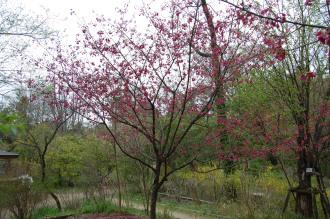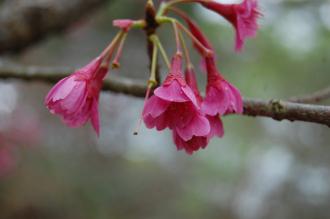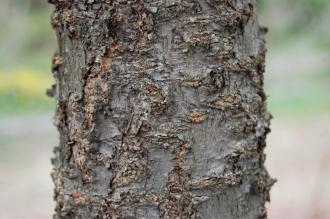
Prunus campanulata (04/04/2015, Kyoto Botanic Gardens, Kyoto, London)
Position: Full sun light shade
Flowering period: Early spring
Soil: Moist, well drained
Eventual Height: 6m
Eventual Spread: 6m
Hardiness: 7b, 8a, 8b, 9a, 9b
Family: Rosaceae
Prunus campanulata is a short lived deciduous tree with a vase shaped habit. Its dark green leaves are obovate with serrate margins, up to 7cm long and 3.5cmm broad. Its leaves turn bronze color in autumn before they fall. Its gray bark is smooth when young, becoming rough with age. Its red pendant flowers are single, bell shaped, up to 2.5cm across, borne in clusters of up to 6 and appear before its leaves. Its red fruit is a spherical cherry and up to 6mm across. Its active roots zone is relatively shallow.

Prunus campanulata Flower (04/04/2015, Kyoto Botanic Gardens, Kyoto, London)
Prunus campanulata, commonly known as Taiwan Cherry, is native to Taiwan, south Japan and south east China. In its native habitat it grows in mixed forests. It should be noted this tree is an invasive plant species in the Northland Region of New Zealand. Prunus campanulata is synonymous with Cerasus campanulata.
The etymological root of the binomial name Prunus is from the classical Latin name of the plum tree. Campanulata is derived from the Latin campana meaning ‘bell’, in reference to its flower shape.
The landscape architect may find Prunus campanulata useful as a small spring flowering tree. The shallow rooting nature of this tree should be considered when planting the tree, as mowers may cut the roots encouraging suckering, creating a maintenance problem.
Ecologically, Prunus campanulata flowers are attractive to pollinating insects. Its fruit is attractive to birds and mammals.

Prunus campanulata Bark (04/04/2015, Kyoto Botanic Gardens, Kyoto, London)
Prunus campanulata prefers moist, fertile, well-drained soils. It tolerates most pH of soil.
Prunus campanulata requires little maintenance. Pruning should be carried out after flowering, from April to July to minimise the risk of Silver leaf infection.

